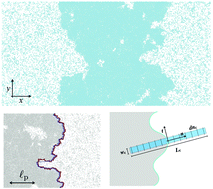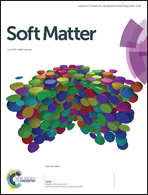Curvature-dependent tension and tangential flows at the interface of motility-induced phases†
Abstract
Purely repulsive active particles spontaneously undergo motility-induced phase separation (MIPS) into condensed and dilute phases. Remarkably, the mechanical tension measured along the interface between these phases is negative. In equilibrium this would imply an unstable interface that wants to expand, but these out-of-equilibrium systems display long-time stability and have intrinsically stiff boundaries. Here, we study this phenomenon in detail using active Brownian particle simulations and a novel frame of reference. By shifting from the global (or laboratory) frame to a local frame that follows the dynamics of the phase boundary, we observe correlations between the local curvature of the interface and the measured value of the tension. Importantly, our analysis reveals that curvature drives sustained local tangential motion of particles within a surface layer in both the gas and the dense regions. The combined tangential current in the gas and local “self-shearing” of the surface of the dense phase suggest a stiffening interface that redirects particles along itself to heal local fluctuations. These currents restore the otherwise wildly fluctuating interface through an out-of-equilibrium Marangoni effect. We discuss the implications of our observations on phenomenological models of interfacial dynamics.



 Please wait while we load your content...
Please wait while we load your content...